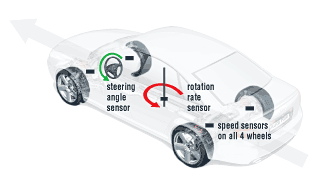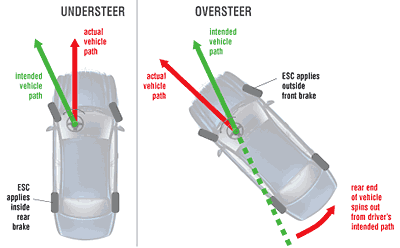About half of the 28,000 fatal passenger vehicle crashes that occur each year involve a single vehicle. Equipping cars and SUVs with electronic stability control (ESC) can reduce the risk of involvement in these crashes by more than 50 percent. The effect on all single-vehicle crashes (fatal and nonfatal) is somewhat less (about 40 percent), and the effect on multiple-vehicle crashes is much less. These are the main findings of a new Insurance Institute for Highway Safety study comparing crash rates for cars and SUVs with and without ESC.
How ESC works: ESC is an extension of antilock brake technology, which has speed sensors and independent braking for each wheel. For ESC, additional sensors continuously monitor how well a vehicle is responding to a driver's steering input. These sensors detect when a vehicle is about to stray from the driver's intended line of travel (that is, lose control), which usually occurs in high-speed maneuvers or on slippery roads. Then ESC brakes individual wheels automatically to keep the vehicle under control.
"For most drivers ESC isn't likely to activate frequently. For example, it won't prevent most of the fender-bender crashes that occur so often in stop-and-go traffic," says Susan Ferguson, Institute senior vice president for research. "ESC is designed to help a driver in the relatively rare event of loss of control at high speed or on a slippery road. When a driver enters a curve too fast, for example, the vehicle may spin out of control. But with ESC, automatic braking is applied to help keep the vehicle under control."
Effects of Esc on Crash Risk:
Percent change in crash rates per registered vehicle year for cars and SUVs with standard ESC vs. optional or no ESC
Findings of the Institute study: The new study indicates that ESC reduces crash risk and is most effective in reducing fatal single-vehicle crashes. This isn't surprising because such crashes typically are characterized by drivers losing control of their vehicles, often on curves.
Specific findings of the Institute study include these: ESC reduced fatal single-vehicle crash risk by about 56 percent. The fatality risk reduction for crashes involving two or more vehicles (17 percent) wasn't statistically significant. ESC reduced the risk of all single-vehicle crashes (fatal and nonfatal) by 41 percent.
To establish these results, Institute researchers analyzed police-reported crashes in 7 states over 2 years as well as data from the federal Fatality Analysis Reporting System. The researchers analyzed the crash rates (all crashes, injury crashes, and fatal crashes per registered vehicle year) of cars and SUVs with ESC as standard equipment versus prior versions of these vehicles when they weren't equipped with ESC or ESC was available only as an option (very few vehicles were equipped with this option). The comparison vehicles were restricted to earlier models that were physically identical to the ESC-equipped vehicles in all respects except for ESC.
Automakers are equipping their vehicles with various versions of ESC and marketing the systems under various names. The Institute's study included Audi, Mercedes, and Volkswagen vehicles with Electronic Stability Program; BMW and Jaguar vehicles with Dynamic Stability Control; Lexus and Toyota vehicles with Vehicle Stability Control; Cadillacs with StabiliTrak; Chevrolets with Active Handling; Volvos with Dynamic Stability and Traction Control; and Acuras with Vehicle Stability Assist.
Not all ESC systems are identical. The hardware is similar, but there are variations in the way the systems are programmed to respond once loss of control is detected. Some ESC systems activate sooner than others or slow a vehicle more quickly when a driver begins to lose control. However, data were insufficient for Institute researchers to compare the effectiveness of different versions of ESC. Nor were data sufficient to compare ESC effectiveness in cars versus SUVs.
"SUVs typically have high single-vehicle rollover rates, and these crashes usually involve drivers losing control of their vehicles," Ferguson says," so it wouldn't be surprising if SUVs benefited more from ESC. This will be a subject of future study when more vehicles are equipped with ESC and data are more plentiful."
Other studies indicate ESC effectiveness: Previous studies of ESC in Europe and Japan as well as a study recently conducted by the U.S. National Highway Traffic Safety Administration reported results in line with the Institute's findings. Some of these studies assumed that certain types of crashes (in particular, multiple-vehicle crashes) wouldn't be affected by ESC, and none of the studies except the Institute's controlled for differences between study and comparison vehicles other than the addition of ESC. NHTSA reported a 35 percent reduction in single-vehicle crash risk for cars and a 67 percent reduction for SUVs. Fatal single-vehicle crashes were reduced about 30 percent (cars) and 63 percent (SUVs).
Potential to save lives: Together these studies, including the Institute's new one, indicate that widespread application of ESC in the vehicle fleet can be expected to afford a significant safety benefit. If all vehicles on U.S. roads had ESC, we might avoid as many as 800,000 of the 2 million or so single-vehicle crashes that occur each year. About 14,000 fatal single-vehicle crashes occurred in 2003, which means there's a potential to save more than 7,000 lives each year.
ESC AND HOW IT HELPS DRIVERS MAINTAIN CONTROL

What is ESC? Electronic stability control, or ESC, uses the speed sensors on each wheel and the ability to brake individual wheels that are the basis of antilock brakes. ESC adds a steering angle sensor, a vehicle rotation rate sensor that measures rotation around the vehicle's vertical axis, and a control unit. The control unit monitors when the steering and rotation sensors detect that the vehicle is about to travel in a direction different from the one indicated by the steering wheel position. Then ESC automaticaly brakes the appropriate wheel to help the driver maintain control. In many cases engine throttle also is reduced.
How ESC Helps Drivers Maintain Control: A driver loses control when the vehicle goes in a direction different from the one indicated by the position of the steering wheel. This typically occurs when a driver tries to turn very hard (swerve) or to turn on a slippery road. Then the vehicle may understeer or oversteer.
When it OVERSTEERS it turns more than the driver intended because the rear end is spinning or sliding out.

When a vehicle UNDERSTEERS it turns less than the driver intended and continues in a forward direction because the front wheels have insufficient traction. ESC can prevent understeering and oversteering by briefly braking the appropriate wheel. In many cases engine throttle also is reduced.
2005 MODEL CARS & SUVS WITH ELECTRONIC STABILITY CONTROL
| Make | Model | Electronic Stability Control |
| ACURA | TL, RL, MDX, TSX | standard |
| AUDI | all models | standard |
| BMW | all models | standard |
| BUICK | LaCrosse, LeSabre | optional |
| Park Avenue, Terraza | optional | |
| CADILLAC | all except CTS, DeVille | standard |
| CTS, DeVille | optional | |
| CHEVROLET | Corvette | standard |
| Suburban | optional | |
| Tahoe, Uplander | optional | |
| CHRYSLER | 300 | optional |
| Crossfire | standard | |
| DODGE | Magnum | optional |
| FORD | Expedition | optional |
| Explorer | standard | |
| Freestar | optional | |
| GMC | Yukon, Yukon XL | optional |
| HONDA | CR-V, Odyssey | standard |
| Pilot | optional | |
| HYUNDAI | Tuscon | standard |
| INFINITI | all models | standard |
| JAGUAR | all models | standard |
| JEEP | Grand Cherokee | optional |
| KIA | Amanti, Sportage | optional |
| LAND ROVER | LR3, Range Rover | standard |
| LEXUS | all except ES 330, IS 300 | standard |
| ES 330, IS 300 | optional | |
| LINCOLN | Aviator | standard |
| LS | optional | |
| Navigator | standard | |
| MAZDA | RX-8 | optional |
| MERCEDES | all models | standard |
| MERCURY | Monterey | optional |
| Mountaineer | standard | |
| MINI | Cooper | optional |
| MITSUBISHI | Endeavor | optional |
| Montero | standard | |
| NISSAN | 350Z, Maxima, Murano | optional |
| Pathfinder, Pathfinder Armada | standard | |
| Quest, Xterra | optional | |
| PONTIAC | Bonneville, Grand Prix | optional |
| Montana SV6, Vibe | optional | |
| PORSCHE | all models | standard |
| SAAB | 9-3, 9-5, 9-7X | standard |
| SATURN | RELAY | optional |
| SCION | xB | standard |
| SUBARU | Outback | optional |
| TOYOTA | 4Runner, RAV4 | standard |
| Avalon | optional | |
| Camry, Camry Solara | optional | |
| Corolla | optional | |
| Highlander, Land Cruiser | standard | |
| Matrix, Prius | optional | |
| Sequoia | standard | |
| Sienna | optional | |
| VOLKSWAGEN | all models | optional |
| VOLVO | all except XC90 | optional |
| XC90 | standard |




